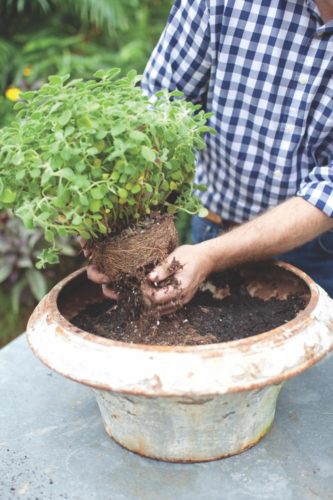I love to plant a container for the senses—a composition that looks, feels, smells, and tastes wonderful. It can even sound wonderful too with just the right rustling of leaves.
I have a weakness for planters, pots, urns, and jardinières with flaky paint and rusty façades. It’s that perfect mix of high and low styles—an earthy surface melded with the container’s good design. Engaging the other senses through plants thus becomes paramount to balance the visual delight.
You will find chartreuse, silvery white, sage, and jade within the plants I chose and on the grain of the urn itself. It is a harmony of these shades that thrills me.
Materials
- sphagnum moss
- Cuban oregano
- ‘Provence’ lavender
- ‘Angelina’ sedum
- Greek columnar basil
- curly leaf parsley
- dusty miller
- orange mint
Tools & Supplies
- antique cast-iron urn
- terra-cotta shards
- my “Farmer’s mix” planting medium (finely ground pine bark, sphagnum moss, mushroom or manure compost, and a built-in time-release fertilizer)
- long, narrow-spouted watering can

1 | Layer the bottom of the planter with terra-cotta shards. This prevents water from running out too fast from the drainage hole and keeps the potting soil from seeping out. Gravel or wire mesh work well too.

2 | Fill the container about half full with potting soil. Tamp it down to provide a sturdy base for plants to begin their growth. Planted compositions such as these are intended for instant gratification and can serve as temporary centerpieces before being repurposed throughout the garden.

3 | Break up, massage, and score the root ball before planting, as shown here with the Cuban oregano. In a tight planting situation, breaking up the excess soil allows for more planting room. Plus, this stimulates the roots for growth.

4 | Start with your larger plants and fill in with your smaller specimens. I’m always reminded of children’s choir at church—arrange the taller kids in the back and the shorter kids up front. Here, the taller plant, Greek columnar basil, acts as a sentinel for the anchor plant, Cuban oregano. Then add the ‘Angelina’ sedum around the base.

5 | No two leaves and no two plants are identical. The narrow leaves of the ‘Provence’ lavender are a lovely complement to the wider, rounder leaves of the Cuban oregano. Now that shape contrast is underway, interject color contrast. Enter dusty miller. This silvery gray-green is a sharp contrast to the purer green oregano and basil, but the lavender is a good middle hue.

6 | Sometimes a plant is really several individual plants growing together. I often split plants, such as this orange mint, to increase the volume of my plant material and give me slender specimens.

7 | In kindergarten I was reprimanded for eating a green crayon. “I wanted to taste the color green” was my defense. Parsley is my panacea for planters, for it’s a green I can eat anytime! Here it fills in space and spills over the edge of the urn.

Ideal for an outdoor dinner table or buffet, after the party, replant the plants in this container herb garden in your planting beds.
— James Farmer
Produced by Pamela Hollon | Photography by Caroline Petters





